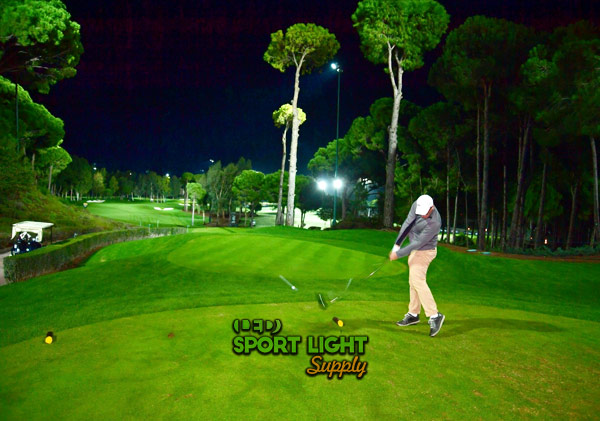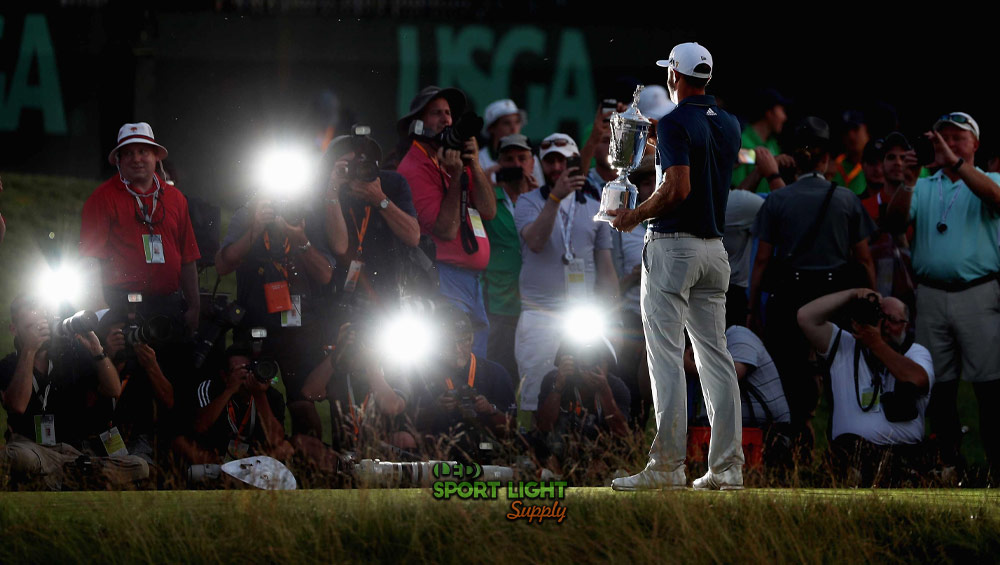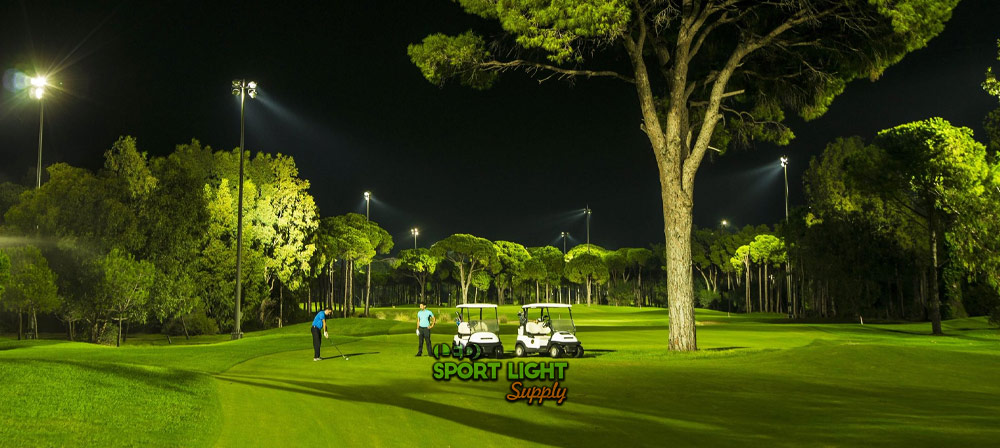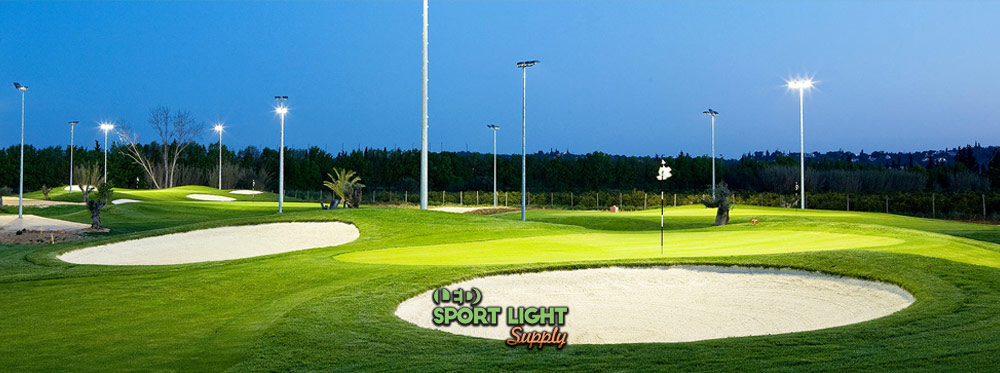The wattage and lumen output required for a golf course lighting system vary based on the specific characteristics of the golf facility, such as whether it covers a vast mountainous area or a smaller, flat region. To determine the most suitable flood light system, it’s essential to consider the watt per lumen ratio. LED lighting is highly recommended for both driving and putting greens due to its efficiency and effectiveness.
To provide a comprehensive overview, I have compiled relevant information on the key factors influencing lighting choices. This includes an explanation of why appropriate lighting is necessary, as well as insights into performance and safety considerations. I will also offer examples of lighting setups for an 18-hole golf course and a driving range, along with expert tips to help you select the best lights and minimize overall energy costs.
Table of Contents
ToggleImportance of Bright Golf Course and Driving Range Lighting

Improve Golfers’ Performance
Adequate lighting plays a crucial role in enhancing golfers’ performance on the course. Good illumination allows golfers to better assess their surroundings, which is essential for making precise shots and avoiding hazards. Proper lighting helps players analyze the fairway, enabling them to avoid rough areas and execute complex shots more effectively. Conversely, inadequate lighting can lead to poor performance, as players may struggle to see obstacles or detect imperfections on the course. It’s important to strike a balance; while sufficient lumens are necessary, excessive brightness can cause glare, negatively impacting visibility and performance.
Bright and Flicker-Free Lighting for Broadcasting Golf Tournaments

For golf tournaments broadcasted on television, the quality of lighting becomes a critical technical consideration. The lighting must be bright enough to ensure clear and detailed video footage, while also being compatible with broadcasting technology. Flicker-free LED lights are the ideal choice for this purpose. Standard LED lights may exhibit flickering that can degrade video quality, leading to poor streaming experiences. Flicker-free lighting solutions meet the technical specifications required for high-quality television broadcasts, ensuring that viewers enjoy a seamless and professional viewing experience.
Golf Cart Driving Safety

Golf cart safety is another important aspect influenced by lighting. The expansive nature of a golf course means that golfers frequently navigate through potentially hazardous areas. Adequate lighting helps in identifying obstacles and uneven surfaces, reducing the risk of accidents and damage to the golf cart. Good illumination also enhances overall safety by allowing golfers to see and avoid potential dangers, such as wild animals or difficult terrain. In some regions, this could even include avoiding encounters with dangerous wildlife.
Security
Effective lighting is essential for ensuring the security of golf facilities. High-profile golf courses, like those found at universities or prestigious clubs, may be targets for theft or vandalism. Implementing security lighting measures, such as LED flood lights with automatic sensors that activate when natural light fades, can help deter criminal activity. Solar-powered lights are also a practical option for maintaining evening illumination and enhancing security. Additionally, security lighting ensures safe navigation for golfers and staff during emergencies, such as fires or other threats.
The table below summarizes the pros and cons of different lighting solutions for golf courses:
| Lighting Solution | Pros | Cons |
|---|---|---|
| LED Lights | Energy-efficient, long-lasting, customizable | Standard LEDs may flicker if not specifically designed |
| Flicker-Free LEDs | Ideal for broadcasting, eliminates flicker | Can be more expensive than standard LEDs |
| Solar-Powered Lights | Environmentally friendly, reduces electricity costs | Initial installation cost can be high, limited by sunlight availability |
| LED Flood Lights | High brightness, effective for security and performance | May require additional maintenance for sensor systems |
Factors Affecting Watts and Lumens of Golf Course Lighting
Size of the Golf Course

The size of the golf course significantly impacts the required wattage and lumen output. Larger courses, such as those with 18 holes, will require more powerful lighting solutions compared to smaller courses with 9 or 3 holes. The efficiency of the lighting system is crucial, as it affects both performance and energy costs. For extensive courses, more lights and potentially additional light poles are needed to ensure uniform illumination across the entire area, from the fairway to the greenside bunkers. Proper lighting enhances comfort and safety for players by providing consistent visibility during their shots.
Light Source
The type of light source chosen affects both brightness and energy consumption. Higher wattage does not necessarily equate to greater brightness. For instance, a 100W LED light can produce the same amount of light as a 1000W halogen bulb but with significantly lower energy consumption due to its higher luminous efficacy. When planning lighting for a golf course, focus on the lumen output rather than just the wattage of individual light sources. This approach allows for better calculation of the number of lights needed and helps in forecasting overall energy costs.
Golf Course Light Pole Height
The height of light poles around the golf course impacts the lighting efficiency. Typically, light poles range from 15 to 30 meters in height. Taller poles require more wattage and lumen output to compensate for increased light loss over greater distances. Additionally, light poles may need to be tall enough to avoid interference with nearby trees or other obstacles. Some poles are designed to mimic tree structures to blend into the landscape while providing effective illumination. The design of lighting around the green and fairway often includes circular lighting to address specific lighting needs in these areas.
Number of Golf Course Light Poles
The number of light poles installed affects the distribution of light and the wattage required for each pole. Fewer poles with lower density mean each pole covers a larger area, leading to greater light loss and higher wattage per pole. Conversely, a higher density of poles ensures more even illumination with lower wattage requirements per pole. The layout of the golf course and the spacing between poles should be carefully planned to optimize lighting efficiency and minimize energy consumption.
Beam Angle of Golf Course Flood Lights
The beam angle of flood lights affects their efficiency and the amount of lumens needed. Flood lights with a wide beam angle (>60 degrees) require more lumens because the light is distributed over a larger area, leading to increased light loss. In contrast, lights with a narrow beam angle are more concentrated, often producing a higher luminous flux for long-range illumination. The choice of beam angle should align with the specific lighting needs of different areas on the course. For example, broad beam angles are better suited for shorter distances, while narrow beam angles are ideal for targeting specific areas with greater intensity.
The table below summarizes the key factors affecting golf course lighting and their implications:
| Factor | Impact |
|---|---|
| Size of the Golf Course | Larger courses require higher wattage and more lumens |
| Light Source | LED lights are more efficient; wattage does not always equal brightness |
| Golf Course Light Pole Height | Taller poles need more wattage to counteract light loss |
| Number of Light Poles | Fewer poles require higher wattage per pole; more poles reduce wattage per pole |
| Beam Angle | Wider angles require more lumens due to increased light loss |
How to Calculate the Lumens and Watts Needed for an 18-Hole Golf Course?
Assuming the standard size of an 18-hole golf course is 100 acres (404,700 square meters), the required lux for a recreational golf course is 200 lux. Therefore, the lumens required for an 18-hole golf course are calculated as follows:
404,700 square meters × 200 lux × 1.25 (light loss factor) = 101,175,000 lumens.
Given that LED lighting efficiency is approximately 150 lumens per watt, the wattage required for an 18-hole golf course can be determined as:
101,175,000 lumens / 150 lumens per watt = 674,500 watts (of LED golf course lights).
Thus, approximately 700,000 watts are necessary for a 100-acre golf course. However, this figure may vary since some parts of the golf course, such as the rough, lake, or even parts of the fairway, may not require lighting.
If using metal halide or mercury vapor lights, you would need around 1,400,000 watts, as their luminous efficacy is approximately 75 lumens per watt. With halogen lights, the requirement would rise to 7,000,000 watts due to their lower luminous efficacy of 15 lumens per watt.
How Many Lumens and Watts Are Needed to Light a Golf Driving Range?
Assuming a standard driving range measures 300 meters in length and 50 meters in width, the total area is 15,000 square meters. The required lux for the driving range is 150 lux. To calculate the lumens required for driving range floodlights, use the following formula:
15,000 square meters × 150 lux × 1.25 (light loss factor) = 2,812,500 lumens.
Therefore, the total wattage required for driving range lighting is:
2,812,500 lumens / 150 lumens per watt = 18,750 watts.
As with the previous example for an 18-hole golf course, this calculation uses the lumen-to-watt ratio for LED light sources. LED floodlights are commonly used for illuminating driving ranges due to their efficiency and effectiveness.
How to Reduce Lumens and Wattage Required for a Golf Driving Range
Using Shorter Light Poles
One effective method to reduce the required lumens and wattage for lighting a golf driving range is to use shorter light poles. This approach minimizes light loss because the light travels a shorter distance, though it may come with higher pole costs. Implementing shorter poles generally means more poles are needed to achieve uniform lighting. Choosing LED lights with reduced glare is essential for maintaining player comfort. Although this method requires more equipment, it is particularly suitable for modest driving ranges with a few uncovered hitting areas.
Using a Small Beam Angle to Light a Large Section
Another approach is to use high-power LED spotlights with a small beam angle. This technique concentrates the light, reducing overall light loss. While it may slightly decrease lighting uniformity, it allows coverage of larger sections of the driving range. To address potential issues with ball visibility and uniformity, consider using targets and yard markers in each hitting area. This method is also useful for junior and beginner golf practices.
Replacing Traditional Lights with LEDs
Replacing older lighting fixtures such as metal halide, mercury vapor, or high-pressure sodium (HPS) lamps with LED lights can significantly reduce both lumens and wattage. LEDs offer higher luminous efficacy, leading to substantial savings on electricity bills. Here’s a comparison of energy savings with LEDs:
| Light Source | Savings with LEDs |
|---|---|
| HPS fittings | 93% |
| Halogen bulbs | 90% |
| Metal halide lamps | 70% |
Mercury vapor and HPS lights are generally too costly to justify their use in modern golf courses. LEDs now offer better color rendering and efficiency, making them a superior choice.
Using Solar Lights to Cut Electricity Costs
To further reduce running costs, consider integrating solar flood lights into your golf driving range lighting plan. Typically, about 10% to 25% of the lighting can be switched to solar power. While a full transition to solar lighting is impractical due to the high power demands, solar lights can be effectively used in areas like tee boxes or along the fairway where shorter poles are feasible.
Obtaining a Photometric Lighting Design
A photometric lighting design can optimize the performance of your lighting setup and reduce overall lumens and wattage. Professionals use tools and expertise to create a custom lighting design, often employing software like DIALux. This software simulates lighting outcomes, including lux levels, lighting uniformity, and glare ratings. A photometric study ensures that your golf driving range lights are optimized to meet specific needs, providing a tailored solution that can lead to significant savings.
Conclusion
To effectively manage the lumen output and wattage for lighting a golf driving range, consider both retrofitting existing systems and implementing new technologies. An expert photometric report can offer the best results and cost savings. If you are involved in designing or upgrading a golf course or driving range, ensure that all areas, including driving greens and putting greens, are appropriately covered. LED lighting remains the most efficient option, and strategically placed solar lights can further reduce running costs.
